مقدمة
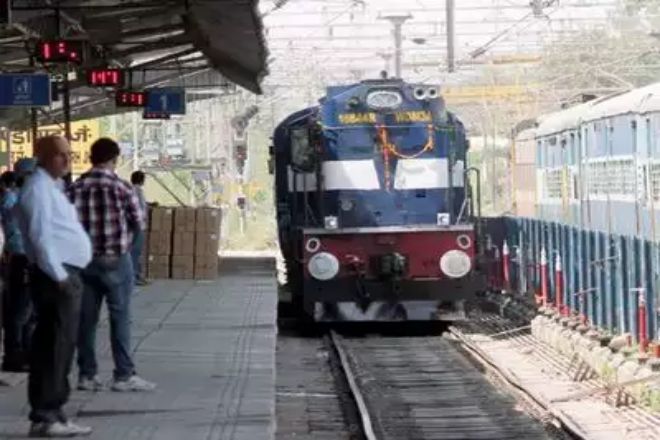
باعتبارها مركزًا مهمًا للنقل في المدينة، تنقل محطة السكك الحديدية عشرات الآلاف من الركاب كل يوم، كما أن النقل الدقيق والتواصل الفعال للمعلومات التي تقدمها أمر بالغ الأهمية.
مع مزاياها الفريدة، شاشات عرض LED يلعب دورًا مزدوجًا في نقل المعلومات والإعلان داخل محطة القطار وخارجها. فهو لا يوفر للركاب معلومات سفر دقيقة وفي الوقت المناسب فحسب، بل يُضفي أيضًا متعةً وراحةً على وقت انتظارهم من خلال عرض محتوى ملون.
1. مزايا استخدام شاشات العرض LED في محطات السكك الحديدية
تتجلى مزايا استخدام شاشات العرض LED في محطات السكك الحديدية بشكل رئيسي في الجوانب التالية:
- تعرض عالي وتغطية واسعة
باعتبارها مركزًا مهمًا للنقل في المدينة، تجذب محطة السكك الحديدية عددًا كبيرًا من الأشخاص كل يوم، مما يتيح لشاشات العرض LED الحصول على تعرض عالي للغاية.
سواء كانت شاشة العرض في قاعة الانتظار أو ساحة الانتظار أو شاشة العرض على العمود الحامل، فإنها يمكن أن تضمن تغطية الإعلانات والمعلومات على نطاق واسع من قبل جميع أنواع الركاب، وبالتالي تحسين الوعي بالعلامة التجارية وكفاءة نقل المعلومات بشكل فعال.
- التسليم المستهدف والوصول الدقيق
تتمتع مجموعات الركاب في محطة السكك الحديدية بخصائص متنوعة، بما في ذلك الأعمار والأجناس والمهن المختلفة، وما إلى ذلك.
من خلال شاشات العرض LED، يمكن للمعلنين تنفيذ تسليم مستهدف وفقًا لفترات زمنية مختلفة، وخصائص الركاب، وعوامل أخرى لضمان وصول محتوى الإعلان بدقة إلى الجمهور المستهدف.
إن استراتيجية التسليم الدقيقة هذه لا تعمل على تحسين فعالية الإعلان فحسب، بل تعمل أيضًا على تقليل هدر الإعلان.
- إصدار المعلومات في الوقت الفعلي والخدمة الفعالة
ميزة رئيسية أخرى لشاشات العرض LED في محطات السكك الحديدية هي أنها يمكن أن تصدر معلومات مختلفة في الوقت الحقيقي، مثل أرقام القطارات، وجداول القطارات، وأوقات المغادرة، ومواقع بوابات التذاكر، وما إلى ذلك. يمكن لنظام إصدار المعلومات في الوقت الحقيقي هذا أن يقلل بشكل كبير من وقت الانتظار وإزعاج الركاب ويحسن كفاءة السفر.
وفي الوقت نفسه، في حالة الطوارئ، يمكن لشاشة العرض LED أيضًا إصدار إشعارات الطوارئ ونصائح السلامة بسرعة لضمان سلامة الركاب.
- العرض الإبداعي والتأثير البصري
مع تطور التكنولوجيا، يتحسن تأثير شاشات العرض LED باستمرار. ويمكن لاستخدامها في محطات القطارات أن يجذب انتباه الركاب بفضل جودة الصورة العالية والمؤثرات الديناميكية والمحتوى الإبداعي، وغيرها.
وخاصة في بعض محطات السكك الحديدية الكبيرة، مثل محطة سكة حديد جينان الغربية، فإن استخدام شاشات LED المنحنية ذات المساحة الكبيرة جدًا لشاشات العرض الإعلانية يمكن أن يحقق تأثيرًا بصريًا قويًا وصدمة للركاب، وبالتالي تعزيز صورة العلامة التجارية وتأثير الإعلان.
- التنوع والمرونة
لا يقتصر استخدام شاشات العرض LED في محطات السكك الحديدية على عرض الإعلانات وإصدار المعلومات، بل يمكن استخدامها أيضًا مع أجهزة أو أنظمة أخرى لتحقيق المزيد من الوظائف.
على سبيل المثال، عند استخدامها مع كاميرات المراقبة وغيرها من المعدات، يمكن تحقيق المراقبة والإشراف في الوقت الحقيقي على محطات السكك الحديدية؛ وعند استخدامها مع الأجهزة التفاعلية، يمكن تحسين مشاركة الركاب وتفاعلهم.
بالإضافة إلى ذلك، يمكن أيضًا تعديل شاشات العرض LED بشكل مرن حسب الحاجة، مثل ضبط محتوى التشغيل، سطوع, زاوية، وما إلى ذلك، لتلبية احتياجات السيناريوهات المختلفة.
- تعزيز صورة وقيمة العلامة التجارية للمدينة.
باعتبارها واحدة من النوافذ المهمة في مدينة، إن صورة وقيمة العلامة التجارية لمحطة السكك الحديدية لها أهمية كبيرة في تطوير المدينة.
إن استخدام شاشات العرض LED للإعلان وإصدار المعلومات في محطات السكك الحديدية لا يمكن أن يعزز الصورة العامة ومستوى محطة السكك الحديدية فحسب، بل يخلق أيضًا جوًا دعائيًا جيدًا وصورة علامة تجارية للمدينة.
في الوقت نفسه، بالنسبة لبعض العلامات التجارية المعروفة، فإن وضع إعلانات LED كما تعد الدعاية الإعلانية في محطات السكك الحديدية طريقة فعالة لإظهار قوة العلامة التجارية وتعزيز قيمتها.
2. التصنيف الأساسي لشاشات العرض LED في محطات السكك الحديدية
يمكن تقسيم شاشات عرض LED في محطات السكك الحديدية إلى عدة فئات حسب مواقع تركيبها واستخداماتها الوظيفية. تعكس هذه التصنيفات الاستخدام الواسع لشاشات عرض LED في محطات السكك الحديدية، كما تُظهر تنوعها ومرونتها.
1) التصنيف حسب موقع التثبيت
1.1). شاشة عرض LED في قاعة الانتظار
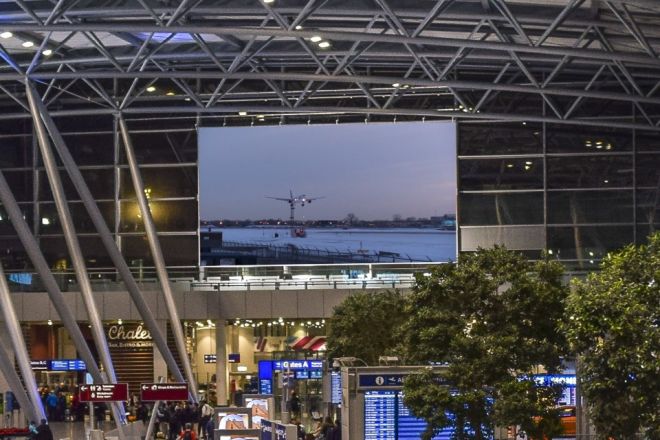
صالة الانتظار هي المكان الرئيسي لانتظار الركاب للقطارات، لذا تتولى شاشة العرض LED المُركّبة فيها مهام عرض معلومات مهمة. تُركّب هذه الشاشات عادةً على جدار أو أرضية صالة الانتظار، باستخدام تقنية LED عالية السطوع والوضوح لضمان عرض واضح في مختلف ظروف الإضاءة.
يتم استخدامها بشكل أساسي لعرض معلومات عملية مثل معلومات القطار ووقت مغادرة القطار وموقع بوابة التذاكر وما إلى ذلك، في الوقت الفعلي، مما يساعد الركاب على فهم ديناميكيات القطار في الوقت المناسب وتحسين تجربة سفرهم.
1.2). شاشة LED مربعة للانتظار
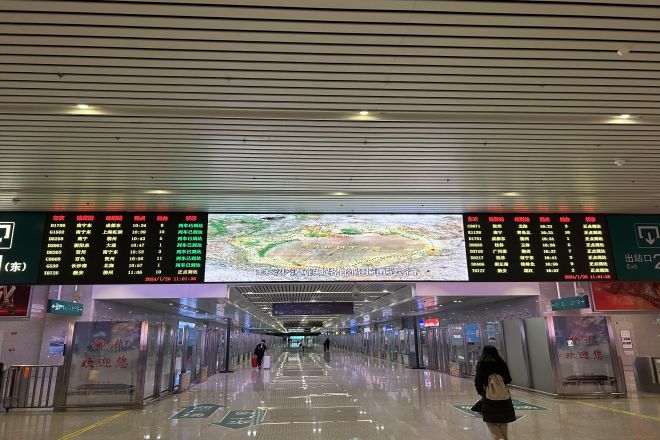
ساحة الانتظار هي المساحة الخارجية لمحطة القطار، وهي أول ما يترك انطباعًا لدى الركاب الداخلين إليها. عادةً ما تعتمد شاشات LED هنا تصميمًا عموديًا، يتضمن أشكالًا متنوعة، مثل الأهرامات المثلثة والكرات والأشكال الخاصة.
إنها ليست جميلة فحسب، بل توفر أيضًا أساليب عرض إعلانية مرنة. يمكن لهذه الشاشات عرض الإعلانات التجارية، والترويج السياحي، والمعلومات العامة، وغيرها من المحتويات لجذب انتباه الركاب، مع تحقيق فوائد تجارية إضافية لمحطة القطار.
1.3). شاشة LED ذات عمود حامل للحمل.
تشكل الأعمدة الحاملة للأحمال في ساحة محطة السكة الحديدية أيضًا مواقع مثالية لتثبيت شاشات LED.
وتستخدم هذه الشاشات المساحة الرأسية للأعمدة الحاملة لعرض المحتوى بأشكال مختلفة، مثل مقاطع الفيديو والصور والنصوص، وهو ما لا يزيد من الشعور بالفن والترفيه فحسب، بل ويستغل أيضًا موارد المساحة بشكل كامل.
يجب أن يأخذ تصميم شاشة العمود الحامل للحمل في الاعتبار عوامل مثل قدرة تحمل الحمل ونطاق زاوية الرؤية لضمان تأثير العرض والسلامة.
2) التصنيف حسب الوظيفة والاستخدام
2.1). شاشة عرض معلومات LED
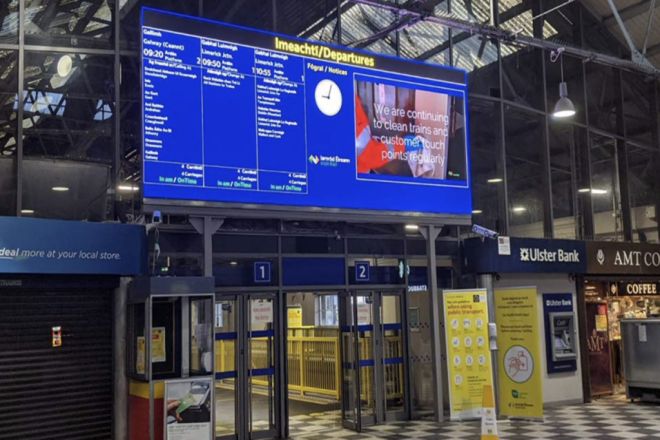
شاشات عرض المعلومات هي أبسط وأهم أنواع شاشات LED في محطات السكك الحديدية. تُستخدم بشكل رئيسي لعرض معلومات عملية، مثل أرقام القطارات، والوقت، وبوابات التذاكر، وغيرها، لتزويد الركاب بإرشادات سفر دقيقة وفي الوقت المناسب.
عادةً ما تستخدم شاشات عرض المعلومات خطوطًا عالية التباين وسهلة القراءة ومجموعات ألوان متناسقة لضمان وضوحها في مختلف الظروف البيئية. فهي لا تُحسّن كفاءة سفر الركاب فحسب، بل تُحسّن أيضًا مستوى الخدمة في محطات السكك الحديدية.
2.2). شاشة اعلانية LED
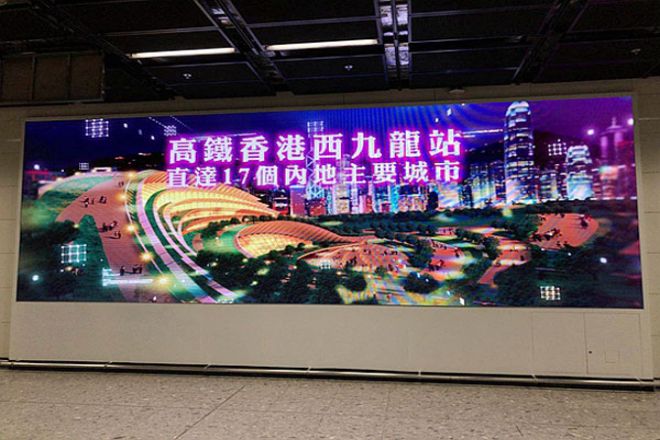
نظراً لكثافة حركة المرور، أصبحت شاشات عرض LED في محطات القطارات بمثابة منصة إعلانية ذهبية يتنافس عليها المعلنون. تُستخدم شاشات العرض بشكل رئيسي لعرض الإعلانات التجارية، والترويج للعلامات التجارية، وغيرها من المحتويات.
بفضل مزاياها، مثل كفاءة الاتصال العالية، والحفظ القوي، وتصميم الإعلانات الجذاب، تُتيح للمعلنين انتشارًا واسعًا وتأثيرًا قويًا على العلامة التجارية. في الوقت نفسه، تُضيف شاشات الإعلانات فوائد تجارية إضافية إلى محطات السكك الحديدية، وتُعزز تنوع عملياتها.
2.3). شاشة عرض LED شاملة
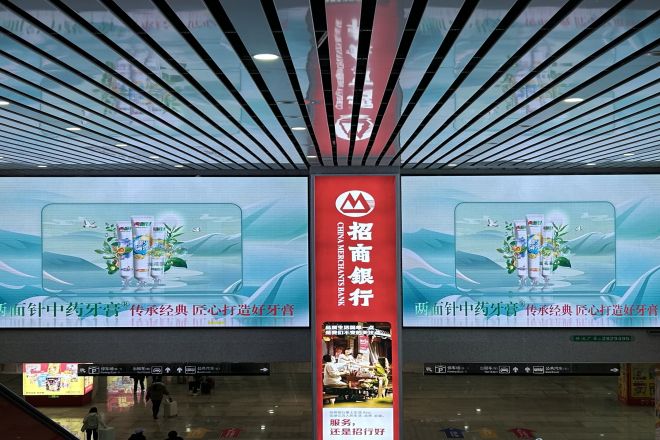
شاشات العرض الشاملة هي مزيج من شاشات عرض المعلومات والإعلانات. تجمع بين وظيفة عرض المعلومات والإعلان. في محطات السكك الحديدية، يمكن تبديل شاشات العرض الشاملة وتعديلها بمرونة لتلبية احتياجات الاستخدام المختلفة.
على سبيل المثال، قبل انطلاق القطار، يُمكن عرض معلومات القطار وتذكيرات الانتظار، وبعد انطلاقه، يُمكن عرض إعلانات تجارية أو عروض سياحية. وقد ساهمت هذه الطريقة المرنة والمتنوعة في استخدام شاشة العرض المتكاملة على نطاق واسع وترويجها في محطات السكك الحديدية.
3. ما هي متطلبات شاشات العرض LED في محطات السكك الحديدية؟
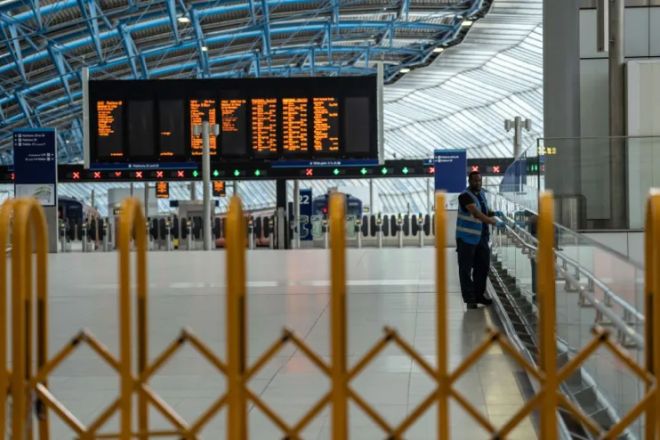
1) تأثير العرض
الحجم و دقةوفقًا لحجم محطة القطار والعدد المتوقع من المشاهدين، يُرجى اختيار حجم ودقة شاشة العرض المناسبة. تتطلب محطات القطارات الكبيرة شاشات أكبر وأعلى دقة لضمان وضوح المعلومات.
السطوع والتباين: نظرًا لأن البيئة الخارجية لمحطة السكة الحديد عادةً ما تكون ساطعة، فيجب أن تتمتع شاشة العرض بسطوع عالٍ وتباين عالٍ حتى تتمكن من قراءة المعلومات بسهولة في ضوء النهار.
اللون والوضوح: يجب أن تكون شاشة العرض قادرة على تقديم ألوان زاهية ودقيقة وتتمتع بدرجة عالية من الوضوح لتوفير تجربة بصرية عالية الجودة.
2) المتانة
مستوى الحماية: يجب أن تتمتع شاشات العرض LED في محطات القطارات بمقاومة جيدة للماء والغبار والصدمات لتتحمل مختلف الظروف الجوية القاسية والبيئات المزدحمة. وعادةً ما تتطلب شاشة العرض مستوى حماية IP65 أو أعلى.
المواد والحرفية: يجب أن تكون مادة شاشة العرض عالية الجودة ومتينة، مثل خزانة الألومنيوم. في الوقت نفسه، يجب تحسين عملية الإنتاج لضمان استقرار وموثوقية الشاشة.
3) المرونة
تحديث المحتوى: يجب أن تتمتع شاشة العرض LED في محطة القطارات بإمكانية تحديث المحتوى بسرعة وسهولة، بحيث يمكن تعديل محتوى العرض في الوقت المناسب حسب الحاجة. يتطلب هذا عادةً نظام العرض دعم الإدارة عن بُعد والتحديثات.
التخطيط والشكل: يمكن تخصيص شاشة العرض وفقًا للتخطيط الفعلي واحتياجات محطة السكة الحديد، مثل المستطيل والمربع والقوس والدائري والأشكال الأخرى وطرق التثبيت (مثل الوقوف على الأرض والمطعمة والمعلقة وما إلى ذلك) للتكيف مع السيناريوهات والاحتياجات المختلفة.
4) السلامة
السلامة الكهربائية: يجب أن تتوافق شاشة العرض مع معايير السلامة الكهربائية ذات الصلة لمنع المخاطر المتعلقة بالسلامة مثل الحرائق الكهربائية.
أمن المحتوى: مع الانتشار الواسع لأنظمة معلومات الركاب (PIS) في محطات السكك الحديدية، ازدادت أهمية أمن تشغيل المحتوى. يحتاج نظام شاشة العرض إلى آليات تدقيق وحماية صارمة لمنع مخاطر مثل سوء التشغيل، أو إهمال التدقيق، أو التلاعب الخبيث.
5) حماية البيئة
استهلاك الطاقةيجب أن تكون شاشات عرض LED في محطات القطارات منخفضة الاستهلاك للطاقة لتقليل تكاليف التشغيل والتأثير البيئي. يتطلب هذا عادةً استخدام رقائق LED عالية الكفاءة ودوائر تشغيل في شاشات العرض.
إعادة تدوير المواد: بعد أن تصل الشاشة إلى عمرها الافتراضي، يجب أن تكون المواد التي صنعت منها قابلة لإعادة التدوير وإعادة الاستخدام بسهولة لتقليل التلوث البيئي.
خاتمة
باختصار، تلعب شاشات العرض LED في محطات السكك الحديدية دورًا حيويًا في نظام النقل الحضري الحديث بفضل تنوعها الفريد وقيمة تطبيقها الواسعة.
من العرض الدقيق والفعال للمعلومات إلى الإبداع غير المحدود للإعلان، ومن السعي الدؤوب للابتكار التكنولوجي إلى الفهم الدقيق لطلب السوق، تزدهر صناعة شاشات العرض LED في محطات السكك الحديدية بسرعة غير مسبوقة.
وأخيرًا، إذا كنت تريد معرفة المزيد عن شاشات العرض LED، يرجى الحصول على اتصال معنا.
